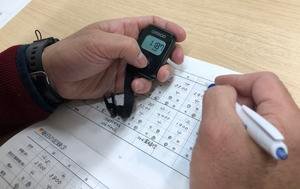image:
After being explained about the importance of increasing physical activity and receiving an accelerometer, study participants who were encouraged to set goals and track their progress and received feedback took an average of 1268 steps per day. This increased from 1683 steps. Duration of light physical activity per day decreased from 277 to 293 minutes, and time spent sitting decreased from 547 to 523 minutes per day. In the control group, which did not track progress or receive feedback, physical activity did not improve.
view more
Credit: Kazuhiro Izawa
Self-monitoring of physical activity with accelerometers and feedback is an effective tool to improve physical activity in older adults who require long-term support. Kobe University research shows for the first time that physical activity can be improved in this population through simple and safe means, which is expected to prevent serious illness and reduce long-term care costs.
It is well known that walking more and sitting less often has a significant impact on a wide range of non-communicable diseases, including heart disease, diabetes, orthopedic conditions, and stroke. This is particularly problematic for older adults who rely on long-term care such as day care centers. This is because they are known to take fewer steps and spend more time sitting than healthy people of the same age. The resulting increased risk of illness not only reduces the health-related quality of life of these populations, but also strains the already scarce resources of the healthcare system. It is also known that self-monitoring can improve physical activity among older adults, but the effectiveness of this approach in this high-risk population has not been shown.
A Kobe University research team consisting of health scientists Kazuhiro Izawa and Masahiro Kitamura conducted a comparative analysis of the effectiveness of self-monitoring of physical activity among 52 long-term care patients at day care centers in Japan. We filled this gap. They educated participants on the importance of increasing physical activity and asked participants to wear accelerometers that tracked steps, time spent sitting, and activity of various intensities. The 26 participants in the intervention group were also asked to record their daily progress on a calendar and received weekly feedback and advice.
The results are now published in the journal geriatric medicine in europe They found that the intervention group took more steps, spent less time sitting, and engaged in more light physical activity. The authors write: “The results of an intervention to promote physical activity in this target population were novel to this study. Older adults in need of long-term care have reduced mobility and activity compared to healthy older adults. However, goals such as increasing your step count are easy to understand and practice, and goals such as reducing time spent sitting, such as standing or taking short walks, can be done indoors. It is an activity that can be done and does not require a high degree of mobility.”
This was the first study to include sedentary time in addition to step counts in self-monitoring, so the two may have influenced each other. Researchers from Kobe University said, “Previous studies in healthy older adults have reported that a decrease in sedentary behavior increases moderate to vigorous physical activity; It’s somewhat similar,” he said. Izawa further added, “While traditional self-monitoring interventions have primarily focused on step count, this study focused on both step count and sedentary behavior. We believe it may have facilitated this.”
While this study clearly demonstrates the effectiveness of simple measures such as wearing an accelerometer, self-monitoring, and receiving feedback on physical activity progress, it does not capture the real benefits on health-related quality of life. The five-week period was too short. Dr. Izawa and Dr. Kitamura said, “The results of this study may provide an important basis for future research on promoting physical activity in older adults who need support.In particular, self-monitoring interventions contribute to improving physical activity.” Future studies should include larger samples, a broader range of activities, and Long-term follow-up must be included.”
This study was supported by JSPS Grants-in-Aid for Scientific Research JP22K11392 and JP23K16629 and the FY2021 University of Medical Science University Support Research Fund, and was carried out in collaboration with researchers at Reiwa Medical University and Rifuru Yukuhashi Nursery School.
Kobe University is a national university with its roots in the Kobe School of Commerce, founded in 1902. Currently, it is one of Japan’s leading comprehensive research universities, with approximately 16,000 students and 1,700 faculty members in 10 faculties/graduate schools and 15 graduate schools. Kobe University, which fuses social and natural sciences and develops leaders with an interdisciplinary perspective, creates knowledge and fosters innovation to address society’s challenges.
journal
geriatric medicine in europe
research method
Randomized comparative/clinical trial
Research theme
people
Article title
Effects of self-monitoring using accelerometers on physical activity in elderly people with long-term care insurance in Japan: A randomized controlled trial.
Article publication date
February 14, 2024
Disclaimer: AAAS and EurekAlert! We are not responsible for the accuracy of news releases posted on EurekAlert! Use of Information by Contributing Institutions or via the EurekAlert System.


